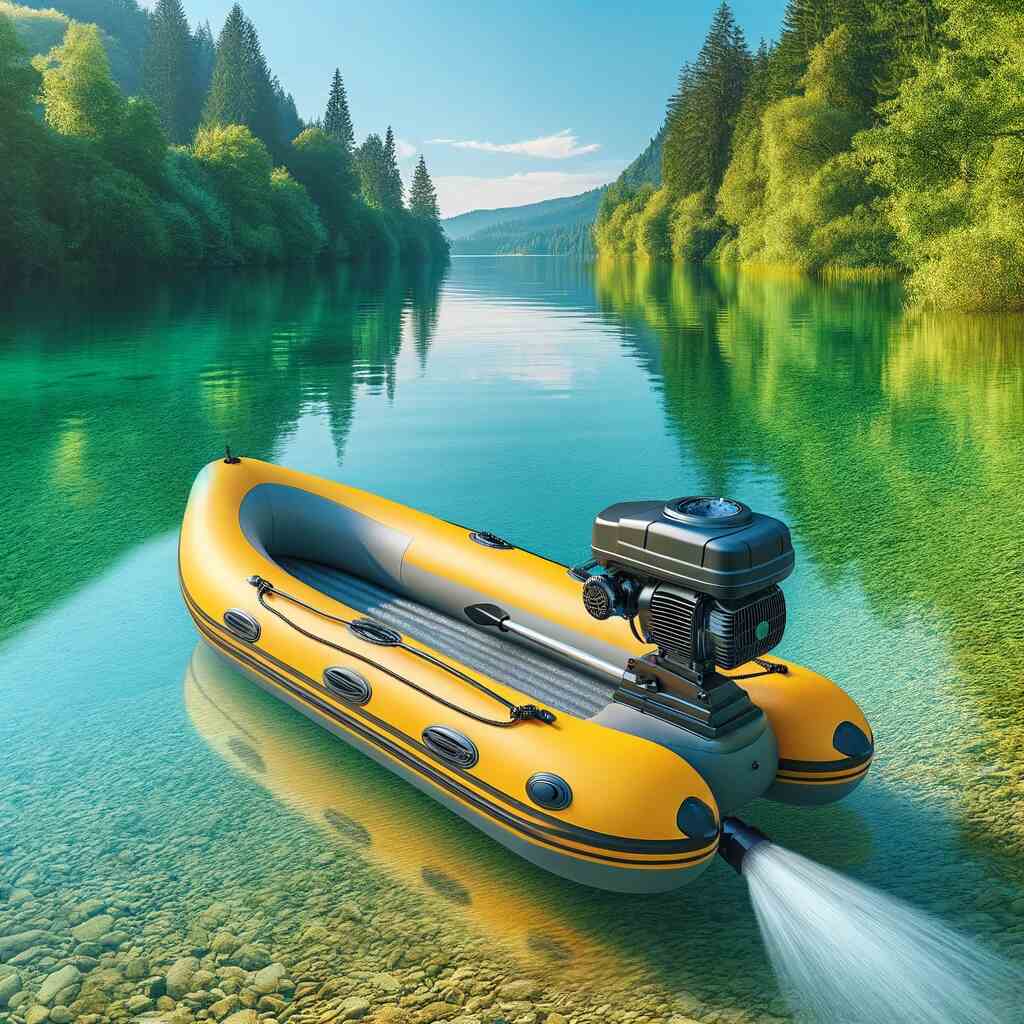In recent years, inflatable kayaks have gained immense popularity among outdoor enthusiasts and water adventurers. These portable and versatile vessels offer a convenient way to explore lakes, rivers, and even the ocean. While paddling is the traditional means of propelling these kayaks, many individuals wonder if it’s possible to attach a motor to an inflatable kayak.
Yes, you can put a motor on an inflatable kayak. However, the feasibility depends on the type of inflatable kayak you have and the type of motor you choose. Sit-on-top kayaks are generally more motor-friendly, while sit-inside kayaks may require modifications.
Electric motors are a popular choice due to their ease of use, while gasoline motors offer more power but come with additional weight and maintenance considerations. Proper installation, weight distribution, and adherence to safety measures are essential when adding a motor to your inflatable kayak to ensure a safe and enjoyable experience on the water.
The Appeal of Inflatable Kayaks
Before delving into the world of motors and inflatable kayaks, let’s first understand why inflatable kayaks have become such a beloved choice for water-based adventures.
1. Portability
Inflatable kayaks are incredibly portable. They can be deflated, rolled up, and stowed away in a compact carrying bag. This portability makes them an ideal choice for individuals who lack the storage space or transportation means for a traditional hard-shell kayak.
2. Durability
Modern inflatable kayaks are designed with durable materials that can withstand rough waters and occasional contact with rocks or other obstacles. While they may not be as rugged as hard-shell kayaks, they offer an excellent balance between durability and convenience.
3. Affordability
Inflatable kayaks tend to be more budget-friendly than their hard-shell counterparts. This affordability makes them an accessible option for beginners or casual kayakers who don’t want to make a significant financial investment.
4. Versatility
Inflatable kayaks are versatile and suitable for various water conditions. Whether you want to paddle on calm lakes, explore slow-moving rivers, or even try some light whitewater, there’s likely an inflatable kayak model that fits your needs.
5. Ease of Use
Setting up an inflatable kayak is relatively simple. Most models come with detailed instructions, and inflating them usually requires nothing more than a hand pump. This ease of use makes them appealing to kayakers of all skill levels.
The Quest for Motorization
While inflatable kayaks are celebrated for their versatility and ease of use, some kayakers may find themselves wishing for a little extra power to cover more significant distances or navigate against strong currents. This desire has led many to ask, “Can you put a motor on an inflatable kayak?”
The answer is yes, it is possible to attach a motor to an inflatable kayak, but several important factors must be considered.
1. Kayak Type and Design
The type of inflatable kayak you own will greatly influence whether or not you can attach a motor. There are three main categories of inflatable kayaks to consider:
a. Sit-On-Top Kayaks
Sit-on-top inflatable kayaks are generally more motor-friendly than other types. Their open design allows for easier motor attachment and control. Many sit-on-top kayaks come with built-in motor mounts or attachment points, making it a straightforward process.
b. Sit-Inside Kayaks
Sit-inside inflatable kayaks, with their enclosed cockpit design, present a greater challenge when it comes to motorization. While it’s still possible to attach a motor, it may require some modifications, and controlling the motor can be less convenient due to the limited space.
c. Canoe-Style Kayaks
Canoe-style inflatable kayaks often have a more spacious design, which can make attaching a motor easier. However, it’s essential to consider the weight distribution and ensure that the motor’s weight won’t cause stability issues.
2. Motor Types
Once you’ve determined that your inflatable kayak can accommodate a motor, the next step is to choose the type of motor that best suits your needs. There are several options available:
a. Electric Motors
Electric motors, also known as trolling motors, are a popular choice for inflatable kayaks. They are quiet, environmentally friendly, and relatively easy to install. Trolling motors are available in various thrust ratings, so you can choose one that matches your kayak’s size and intended use.
b. Gasoline Motors
Gasoline-powered motors are another option, but they are less common for inflatable kayaks due to their weight, noise, and emissions. However, some individuals may prefer the added power and range that a gasoline motor provides.
c. Jet Propulsion Systems
Jet propulsion systems are becoming increasingly popular for inflatable kayaks. These systems use water jets to propel the kayak forward, making them highly maneuverable and suitable for shallow waters. Jet propulsion systems are typically electric and can be a good choice for those seeking agility and control.
3. Mounting and Installation
Proper installation is crucial when attaching a motor to your inflatable kayak. If your kayak comes with a built-in motor mount, follow the manufacturer’s instructions for installation carefully. For kayaks without pre-installed mounts, you may need to use aftermarket motor mount kits. These kits typically include brackets and hardware for attaching the motor securely to the kayak.
4. Battery Considerations
If you opt for an electric motor, you’ll need a suitable marine battery to power it. Ensure that the battery is compatible with the motor and provides enough runtime for your intended use. It’s also essential to securely mount the battery in your kayak to prevent any accidents or damage.
5. Weight Distribution and Stability
Adding a motor to your inflatable kayak will alter its weight distribution. It’s crucial to maintain proper balance to ensure stability and prevent capsizing. Experiment with the placement of the motor and other gear to achieve the best balance for your kayak.
6. Safety Measures
Safety should always be a top priority when using a motorized inflatable kayak. Here are some essential safety measures to consider:
- Wear a life jacket at all times when kayaking.
- Familiarize yourself with the motor’s controls and operation before venturing onto the water.
- Carry essential safety equipment such as a whistle, paddle, and first aid kit.
- Be aware of your surroundings and respect other boaters and wildlife.
- Check local regulations and requirements for motorized watercraft in your area.
Pros and Cons of Motorized Inflatable Kayaks
Now that we’ve explored the process of attaching a motor to an inflatable kayak, let’s weigh the pros and cons to help you decide if it’s the right choice for your kayaking adventures.
Pros:
1. Increased Range and Speed
A motorized kayak allows you to cover more significant distances and navigate against strong currents more easily. This can open up new exploration possibilities and extend the range of your adventures.
2. Reduced Physical Exertion
Paddling can be physically demanding, especially on long trips or in adverse conditions. A motor can alleviate some of the physical strain, allowing you to enjoy your time on the water without excessive effort.
3. Fishing Benefits
For anglers, a motorized kayak can be a game-changer. It provides greater maneuverability and the ability to hold your position in the water, making it easier to target specific fishing spots.
4. Versatility
With a motorized kayak, you have the flexibility to choose between motorized and paddle-propelled modes, depending on your preference and the situation. This versatility can enhance your overall kayaking experience.
Cons:
1. Added Weight and Bulk
Installing a motor and battery can add significant weight and bulk to your inflatable kayak. This may affect its portability and storage convenience, particularly if you have limited space.
2. Noise and Disturbance
Gasoline motors can be noisy and disruptive to the tranquility of natural settings. Electric motors are quieter but still generate some noise. If you enjoy the peacefulness of kayaking in nature, this may be a drawback.
3. Maintenance
Motorized kayaks require regular maintenance of the motor, battery, and associated components. This includes checking for wear and tear, ensuring proper electrical connections, and monitoring battery health.
4. Regulatory Compliance
In many areas, using a motorized kayak may be subject to specific regulations and licensing requirements. It’s essential to research and comply with local laws to avoid legal issues.
Tips for Using a Motorized Inflatable Kayak
If you decide to go ahead with motorizing your inflatable kayak, here are some tips to ensure a safe and enjoyable experience:
1. Practice Operating the Motor
Before heading out on the water, spend some time practicing with the motor in a controlled environment. Familiarize yourself with the controls and get a feel for how the kayak responds to the motor’s thrust.
2. Plan Your Trips Carefully
Plan your kayak trips with the motor in mind. Consider factors such as battery life, wind conditions, and the distance you intend to cover. Always have a backup plan in case the motor encounters issues.
3. Maintain Your Equipment
Regularly inspect and maintain your motor, battery, and kayak. Check for loose connections, worn components, and signs of damage. Keeping your equipment in good condition is essential for safety and reliability.
4. Monitor Battery Life
Pay close attention to your battery’s remaining charge during your outings. It’s advisable to have a battery indicator or gauge on hand to track the battery’s status accurately. Carry a spare battery or a portable charger if needed.
5. Respect the Environment
When using a motorized kayak, be mindful of the environment and the impact of your actions on the natural world. Keep your distance from wildlife, avoid disturbing nesting areas, and follow Leave No Trace principles.
6. Learn Navigation Skills
Even with a motor, it’s essential to have basic navigation skills and an understanding of water currents and conditions. This knowledge will help you make informed decisions while on the water.
Conclusion
Inflatable kayaks offer a convenient and versatile way to enjoy water-based adventures. While adding a motor to an inflatable kayak is possible and can enhance your kayaking experience in various ways, it’s essential to carefully consider the type of kayak you have, the type of motor you want to use, and the associated pros and cons.
By following proper installation and safety guidelines, you can enjoy the benefits of motorization while exploring the beauty of lakes, rivers, and oceans. Remember that, ultimately, the decision to put a motor on your inflatable kayak should align with your specific needs and preferences as a kayaker. Whether you choose to paddle or motorize, the key is to enjoy your time on the water responsibly and safely.










